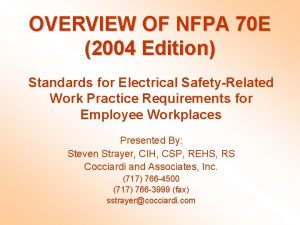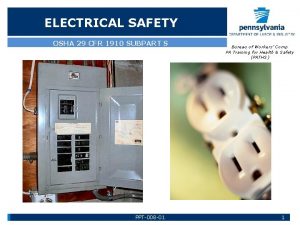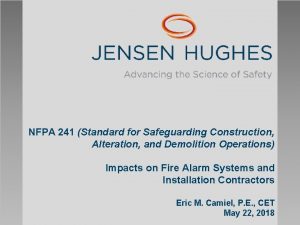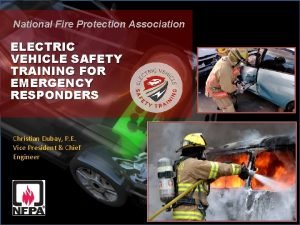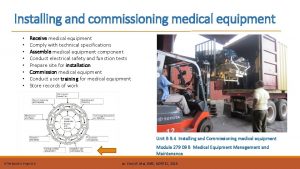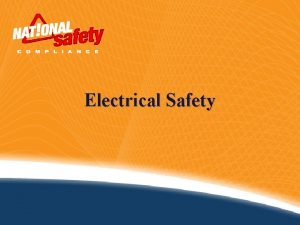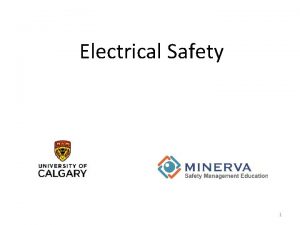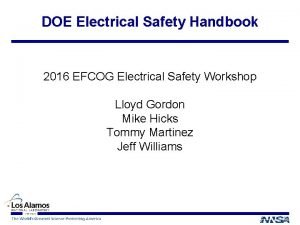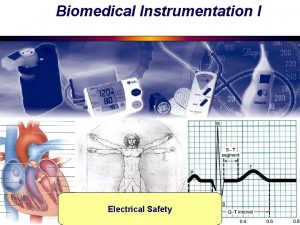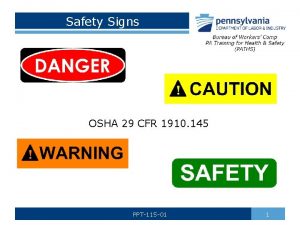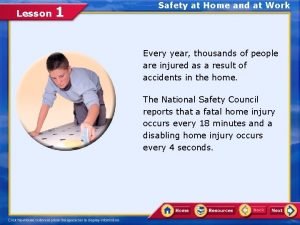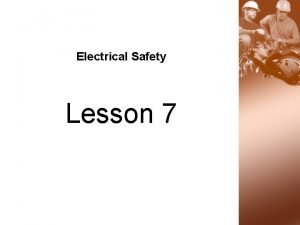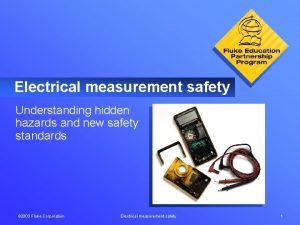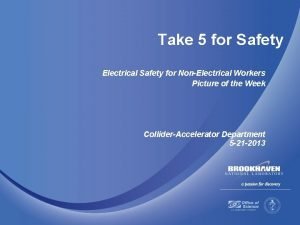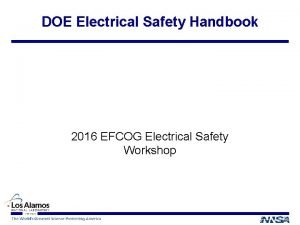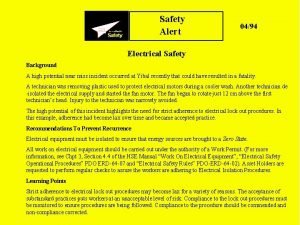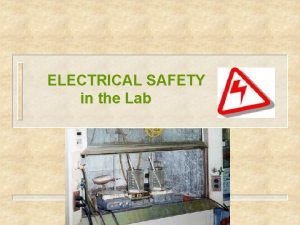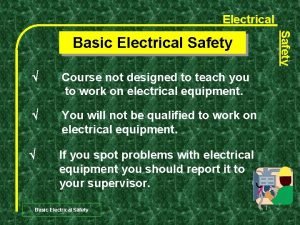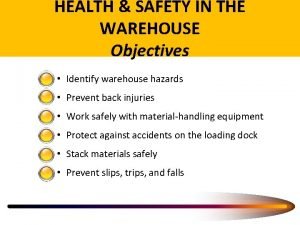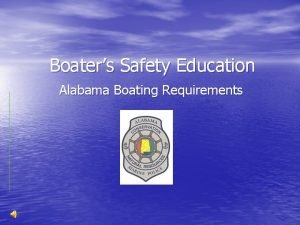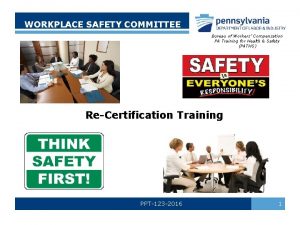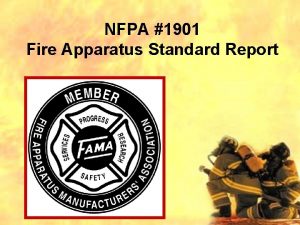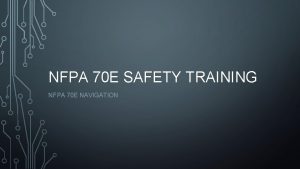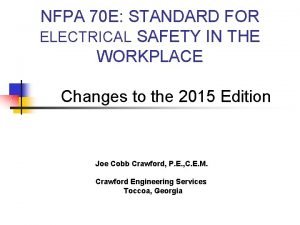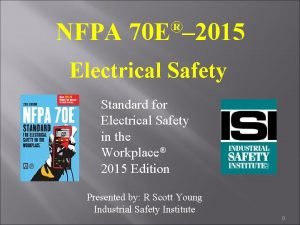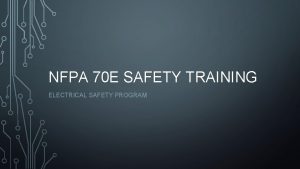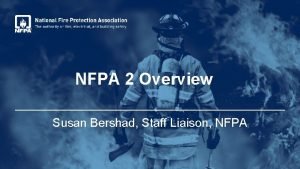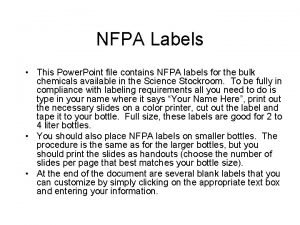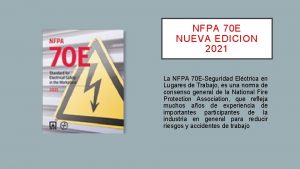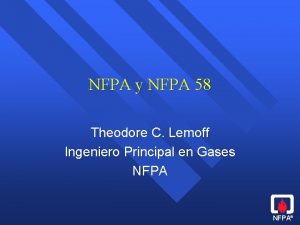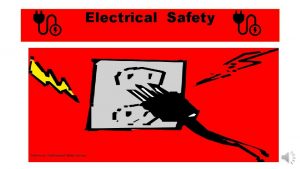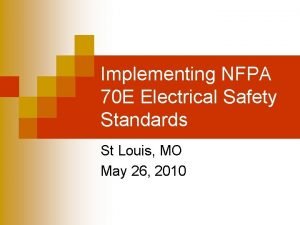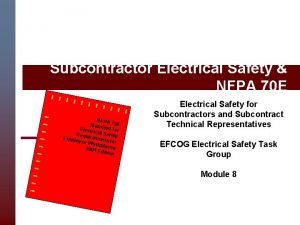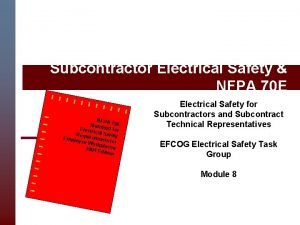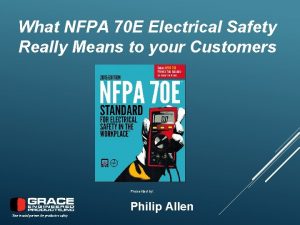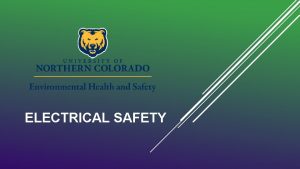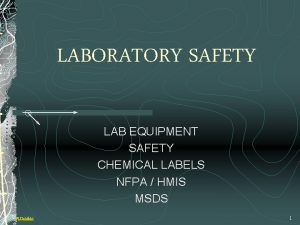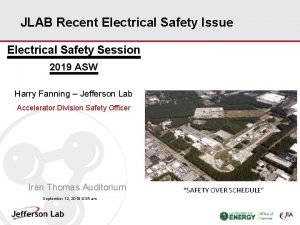NFPA 70 E Standard for Electrical Safety Requirements






































- Slides: 38

NFPA 70 E Standard for Electrical Safety Requirements for Employee Workplaces Article 130 A Operational Guide for Protection Against Shock and Arc Flash

Purpose To provide an additional training resource for the protection of “Qualified Employees” against Shock and Arc Flash Hazards.

What Is Arc Flash? The NFPA 70 E standard defines these flash hazards as “a dangerous condition associated with the release of energy caused by electric arc”.

What Causes An “Arc” Although most arcs are initiated by physical means, the arc itself is the passage of a substantial electrical current through ionized air or other gases. The temperatures may reach as high as 35, 000 degrees F with sound pressures reaching over 160 d. B.

Arc Flash Injuries Each year many un-necessary injuries and fatalities occur to workers while performing task on energized equipment. These injuries often include: ØSevere skin burns ØHearing damage ØEye and face injuries ØDeath

Highest Incidence Arc Flash Fatalities Source BLS

How Do We Prevent These Injuries Engineering controls Ø Energize/de-energize large circuit breakers, disconnects, MCC’s and switchgears remotely Ø Use zone selective interlocking/circuit design Ø Use lengthened tools that allow increased distance Ø Decrease load on involved circuits Ø Identify locations and label electrical panels and equipment as to the hazard category Ø Use metal front arc resistant switchgears and motor control centers

How Do We Prevent These Injuries Administrative controls ØMinimize risk with good safety practices üAlways use LOTO whenever possible! üDe-energize equipment verses “working it hot” üCalculate and establish safe working distances for designated voltage üUtilize appropriate flame resistant PPE for task that require employees to work or verify live voltage üEstablish device/task specific procedures, i. e. JSA’s

Why Do We Calculate Arc Flash Hazards Arc flash hazards are calculated using a formula involving distance and voltage. This can be determined using the IEEE 1584 -2002 standard and the accompanying Excel spreadsheet. It is useful for providing safe working distances and will assist you in providing the level of PPE required for the operation.

Limits of Approach (NFPA Figure A-1 -2. 4) NFPA 70 E, 2004 130. 3(B) provides a table that identifies three categories of Approach Boundaries.

NFPA 70 E and Arc Flash Hazard • Protection Boundaries – NFPA 70 E defines a series of boundaries relating to electrical safety when working on energized equipment. Only "qualified" people can enter these boundaries and they are required to wear appropriate PPE within these boundaries. • The four protection boundaries are: – Flash Protection Boundary – Limited Approach Boundary – Restricted Approach Boundary – Prohibited Approach Boundary • Flash Protection Boundary – The flash protection boundary is the distance from the arc source (energized exposed equipment) at which the potential incident heat energy from an arcing fault falling on the surface of the skin is 1. 2 calories/cm 2. An exposure to 1. 2 cal/cm 2 would normally result in a curable second-degree burn. Within this boundary workers are required to wear protective clothing like fire resistant (FR) shirts and pants, and other equipment to cover various parts of the body. This distance may vary from equipment to equipment since it is a function of the available fault current of the system at that point, the voltage and the tripping characteristics of the upstream protective device as well as some other parameters.

(All dimensions are distance from live part to employee. ) (1) (2) (3) Limited Approach Boundary 1 (4) (5) Restricted Approach Boundary 1 Prohibited Approach Boundary 1 Nominal System Voltage Range, Phase to Phase Exposed Movable Conductor Exposed Fixed Circuit Part Includes Inadvertent Movement Adder Prohibited Approach Boundary 1 0 to 50 Not specified 51 to 300 10 ft 0 in. 3 ft 6 in. Avoid contact 301 to 750 10 ft 0 in. 3 ft 6 in. 1 ft 0 in. 0 ft 1 in. 751 to 15 k. V 10 ft 0 in. 5 ft 0 in. 2 ft 2 in 0 ft 7 in. 15. 1 k. V to 36 k. V 10 ft 0 in. 6 ft 0 in. 2 ft 7 in. 0 ft 10 in 36. 1 k. V to 46 k. V 10 ft 0 in. 8 ft 0 in. 2 ft 9 in. 1 ft 5 in. 46. 1 k. V to 72. 5 k. V 10 ft 0 in. 8 ft 0 in. 3 ft 3 in. 2 ft 1 in. 72. 6 k. V to 121 k. V 10 ft 0 in. 8 ft 0 in. 3 ft 2 in. 2 ft 8 in. 138 k. V to 145 k. V 11 ft 0 in. 10 ft 0 in. 3 ft 7 in. 3 ft 1 in. 161 k. V to 169 k. V 11 ft 0 in. 11 ft 8 in 4 ft 0 in. 3 ft 6 in.

(1) (2) (3) Limited Approach Boundary 1 (4) (5) Restricted Approach Boundary 1 Prohibited Approach Boundary 1 Nominal System Voltage Range, Phase to Phase Exposed Movable Conductor Exposed Fixed Circuit Part Includes Inadvertent Movement Adder Prohibited Approach Boundary 1 230 k. V to 242 k. V 13 ft 0 in 5 ft 3 in. 4 ft 9 in. 345 k. V to 362 k. V 15 ft 4 in. 8 ft 6 in. 8 ft 0 in. 500 k. V to 550 k. V 19 ft 0 in. 11 ft 3 in. 10 ft 9 in. 765 k. V to 800 k. V 23 ft 9 in 14 ft 11 in. 14 ft 5 in

Determining Personal Protective Equipment Although arc flash potential should always be calculated, is there a general rule of thumb as to what PPE is required?

Protective Clothing and Personal Protective Equipment (PPE) Matrix (NFPA Table 3 -3. 9. 2)

Typical Protective Clothing Systems Hazard / Risk Category Clothing Description (Number Total of clothing layers is given in Weig parentheses) ht oz/yd 2 Minimum Arc Thermal Performance Exposure Value (ATPV)* or Breakopen Threshold Energy (EBT)* Rating of PPE cal/cm 2 0 Untreated cotton (1) 4. 5 – 7 N/A 1 FR shirt and FR pants (1) 4. 5 – 8 5 2 Cotton underwear plus FR shirt and FR pants (2) 9 – 12 8 3 Cotton underwear plus FR shirt and FR pants plus FR coverall (3) 16 – 20 25 4 Cotton underwear plus FR shirt and FR pants plus double layer switching coat and pants (4) 24 – 30 40

Protective Clothing & Equipment Hazard/Risk Category Number Protective Systems for Hazard/Risk Category -1 (Note 3) 0 1 2 3 4 Untreated Natural Fiber - - - a. T-shirt (short-sleeve) X X b. Shirt (long-sleeve) X c. Pants (long) X X X (Note 4) X (Note 6) X X FR Clothing (Note 1) - - - X X X (Note 9) X b. Pants X (Note 4) X (Note 6) X (Note 9) X c. Coverall X (Note 5) X (Note 7) X (Note 9) X (Note 5) AN AN a. Long-sleeve shirt d. Jacket, parka, or rainwear

Protective Clothing & Equipment Hazard/Risk Category Number FR Protective Equipment Protective Systems for Hazard/Risk Category -1 (Note 3) 0 1 2 3 4 - - - a. Flash suit jacket (2 -layer) X b. Flash suit pants (2 -layer) X Head protection - - a. Hard hat - - X X X b. FR hard hat liner Eye protection - - - a. Safety glasses X X X AL AL AL Face protection double-layer switching hood AR (Note 8) X X Hearing protection (ear canal inserts) AR (Note 8) X X b. Safety goggles Leather gloves (Note 2) AN X X X Leather work shoes AN X X X

Hazard Risk Category Classification (NFPA Table 3 -3. 9. 1)

Task (Assumes Equipment Is Energized, and Work Is Done Within The Flash Protection Boundary) Hazard / Risk Category V-Rated Gloves V-Rated Tools Panelboards rated 240 V and below – Notes 1 and 3 - - - Circuit breaker (CB) or fused switch operation with covers on 0 N N CB or fused switch operation with covers off 0 N N Work on energized parts, including voltage testing 1 Y Y Remove/install CBs or fused switches 1 Y Y Removal of bolted covers (to expose bare, energized parts) 1 N N Opening hinged covers (to expose bare, energized parts) 0 N N Notes: 1. 25 k. A short circuit current available, 0. 03 second (2 cycle) fault clearing time. 3. For <10 k. A short circuit available, the Hazard / Risk Category required may be reduced by one Number.

Task (Assumes Equipment Is Energized, and Work Is Done Within The Flash Protection Boundary) Hazard / Risk Category V-Rated Gloves V-Rated Tools Panelboards or Switchboards rated >240 V and up to 600 V (with molded case or insulated case circuit breakers) — Notes 1 and 3 _ _ _ CB or fused switch operation with covers on 0 N N CB or fused switch operation with covers off 1 N N Work on energized parts, including voltage testing 2* Y Y Notes: 1. 25 k. A short circuit current available, 0. 03 second (2 cycle) fault clearing time. 3. For <10 k. A short circuit available, the Hazard / Risk Category required may be reduced by one Number. 2* Means that a double-layer switching hood and hearing protection are required for this task in addition to the other Hazard / Risk Category 2 requirements of Table 3 -3. 9. 2 of Part II

Task (Assumes Equipment Is Energized, and Work Is Done Within The Flash Protection Boundary) Hazard / Risk Category V-Rated Gloves V-Rated Tools 600 V Class Motor Control Centers (MCCs) – Notes 2 (except as indicated) and 3 _ _ _ CB or fused switch or starter operation with enclosure doors closed 0 N N Reading a panel meter while operating a meter switch 0 N N CB or fused switch or starter operation with enclosure doors open 1 N N Work on energized parts, including voltage testing 2* Y Y Work on control circuits with energized parts 120 V or below, exposed 0 Y Y Notes: 2. 65 k. A short circuit current available, 0. 03 second (2 cycle) fault clearing time. 2* Means that a double-layer switching hood and hearing protection are required for this task in addition to the other Hazard / Risk Category 2 requirements of Table 3 -3. 9. 2 of Part II 3. For <10 k. A short circuit available, the Hazard / Risk Category required may be reduced by one Number.

Task (Assumes Equipment Is Energized, and Work Is Done Within The Flash Protection Boundary) Hazard / Risk Category V-Rated Gloves V-Rated Tools 600 V Class Motor Control Centers (MCCs) – Notes 2 (except as indicated) and 3 _ _ _ Work on control circuits with energized parts >120 V exposed 2* Y Y Insertion or removal of individual starter “buckets” from MCC — Note 4 3 Y N Application of safety grounds, after voltage test 2* Y N Removal of bolted covers (to expose bare, energized parts) 2* N N Opening hinged covers (to expose bare, energized parts) 1 N N Notes: 2. 2* 65 k. A short circuit current available, 0. 03 second (2 cycle) fault clearing time. 3. 4. For <10 k. A short circuit available, the Hazard / Risk Category required may be reduced by one Number. Means that a double-layer switching hood and hearing protection are required for this task in addition to the other Hazard / Risk Category 2 requirements of Table 3 -3. 9. 2 of Part II 65 k. A short circuit current available, 0. 33 second (20 cycle) fault clearing time.

Task (Assumes Equipment Is Energized, and Work Is Done Within The Flash Protection Boundary) Hazard / Risk Category V-Rated Gloves V-Rated Tools 600 V Class Switchgear (with power circuit breakers or fused switches) — Notes 5 and 6 _ _ _ CB or fused switch operation with enclosure doors closed 0 N N Reading a panel meter while operating a meter switch 0 N N CB or fused switch operation with enclosure doors open 1 N N Work on energized parts, including voltage testing 2* Y Y Work on control circuits with energized parts 120 V or below, exposed 0 Y Y Notes: 2* Means that a double-layer switching hood and hearing protection are required for this task in addition to the other Hazard / Risk Category 2 requirements of Table 3 -3. 9. 2 of Part II 5. 65 k. A short circuit current available, up to 1. 0 second (60 cycle) fault clearing time. 6. For <25 k. A short circuit current available, the Hazard / Risk Category required may be reduced by one Number.

Task (Assumes Equipment Is Energized, and Work Is Done Within The Flash Protection Boundary) Hazard / Risk Category V-Rated Gloves V-Rated Tools 600 V Class Switchgear (with power circuit breakers or fused switches) — Notes 5 and 6 _ _ _ Work on control circuits with energized parts >120 V exposed 2* Y Y Insertion or removal (racking ) of CBs from cubicles, doors open 3 N N Insertion or removal (racking) of CBs from cubicles, doors closed 2 N N Application of safety grounds, after voltage test 2* Y N Removal of bolted covers (to expose bare, energized parts) 3 N N Opening hinged covers (to expose bare, energized parts) 2 N N

Task (Assumes Equipment Is Energized, and Work Is Done Within The Flash Protection Boundary) Hazard / Risk Category V-Rated Gloves V-Rated Tools Other 600 V Class (277 V through 600 V, nominal) Equipment — Note 3 _ _ _ Lighting or small power transformers (600 V, maximum) _ _ _ Removal of bolted covers (to expose bare, energized parts) 2* N N Opening hinged covers (to expose bare, energized parts) 1 N N Work on energized parts, including voltage testing 2* Y Y Application of safety grounds, after voltage test 2* Y N Revenue meters (k. W-hour, at primary voltage and current) _ _ _ Notes: 2* Means that a double-layer switching hood and hearing protection are required for this task in addition to the other Hazard / Risk Category 2 requirements of Table 3 -3. 9. 2 of Part II 3. For <10 k. A short circuit available, the Hazard / Risk Category required may be reduced by one Number.

Task (Assumes Equipment Is Energized, and Work Is Done Within The Flash Protection Boundary) Hazard / Risk Category V-Rated Gloves V-Rated Tools Other 600 V Class (277 V through 600 V, nominal) Equipment — Note 3 _ _ _ Insertion or removal 2* Y N Cable trough or tray cover removal or installation 1 N N Miscellaneous equipment cover removal or installation 1 N N Work on energized parts, including voltage testing 2* Y Y Application of safety grounds, after voltage test 2* Y N Notes: 2* Means that a double-layer switching hood and hearing protection are required for this task in addition to the other Hazard / Risk Category 2 requirements of Table 3 -3. 9. 2 of Part II 3. For <10 k. A short circuit available, the Hazard / Risk Category required may be reduced by one Number.

Task (Assumes Equipment Is Energized, and Work Is Done Within The Flash Protection Boundary) Hazard / Risk Category V-Rated Gloves V-Rated Tools NEMA E 2 (fused contactor) Motor Starters, 2. 3 k. V through 7. 2 k. V _ _ _ Contactor operation with enclosure doors closed 0 N N Reading a panel meter while operating a meter switch 0 N N Contactor operation with enclosure doors open 2* N N Work on energized parts, including voltage testing 3 Y Y Work on control circuits with energized parts 120 V or below, exposed 0 Y Y Work on control circuits with energized parts >120 V, exposed 3 Y Y Insertion or removal (racking ) of starters from cubicles, doors open 3 N N Notes: 2* Means that a double-layer switching hood and hearing protection are required for this task in addition to the other Hazard / Risk Category 2 requirements of Table 3 -3. 9. 2 of Part II

Task (Assumes Equipment Is Energized, and Work Is Done Within The Flash Protection Boundary) Hazard / Risk Category V-Rated Gloves V-Rated Tools NEMA E 2 (fused contactor) Motor Starters, 2. 3 k. V through 7. 2 k. V _ _ _ Insertion or removal (racking) of starters from cubicles, doors closed 2 N N Application of safety grounds, after voltage test 3 Y N Removal of bolted covers (to expose bare, energized parts) 4 N N Opening hinged covers (to expose bare, energized parts) 3 N N Notes: 2* Means that a double-layer switching hood and hearing protection are required for this task in addition to the other Hazard / Risk Category 2 requirements of Table 3 -3. 9. 2 of Part II

Task (Assumes Equipment Is Energized, and Work Is Done Within The Flash Protection Boundary) Hazard / Risk Category V-Rated Gloves V-Rated Tools Metal Clad Switchgear, 1 k. V and above _ _ _ CB or fused switch operation with enclosure doors closed 2 N N Reading a panel meter while operating a meter switch 0 N N CB or fused switch operation with enclosure doors open 4 N N Work on energized parts, including voltage testing 4 Y Y Work on control circuits with energized parts 120 V or below, exposed 2 Y Y Work on control circuits with energized parts >120 V, exposed 4 Y Y Insertion or removal (racking ) of CBs from cubicles, doors open 4 N N

Task (Assumes Equipment Is Energized, and Work Is Done Within The Flash Protection Boundary) Hazard / Risk Category V-Rated Gloves V-Rated Tools Metal Clad Switchgear, 1 k. V and above _ _ _ Insertion or removal (racking) of CBs from cubicles, doors closed 2 N N Application of safety grounds, after voltage test 4 Y N Removal of bolted covers (to expose bare, energized parts) 4 N N Opening hinged covers (to expose bare, energized parts) 3 N N Opening voltage transformer or control power transformer compartments 4 N N

Task (Assumes Equipment Is Energized, and Work Is Done Within The Flash Protection Boundary) Hazard / Risk Category V-Rated Gloves V-Rated Tools Other Equipment 1 k. V and above _ _ _ Metal clad load interrupter switches, fused or unfused _ _ _ Switch operation, doors closed 2 N N Work on energized parts, including voltage testing 4 Y Y Removal of bolted covers (to expose bare, energized parts) 4 N N Opening hinged covers (to expose bare, energized parts) 3 N N Outdoor disconnect switch operation (hookstick operated) 3 Y Y Outdoor disconnect switch operation (gang-operated, from grade) 2 N N

Task (Assumes Equipment Is Energized, and Work Is Done Within The Flash Protection Boundary) Hazard / Risk Category V-Rated Gloves V-Rated Tools Other Equipment 1 k. V and above _ _ _ Insulated cable examination, in manhole or other confined space 4 Y N Insulated cable examination, in open area 2 Y N

Job Planning Additionally, a Energized Electrical Permit has been added to our Electrical Safety Related Work Practices policy to assist you with tracking data and following the necessary steps to complete the work safely. The permitting process should include a job briefing that identifies affected locations/personnel, contacts, specific task, and emergency procedures.

Causes of Electric Arcs can be initiated by the following: • Glow to arc discharge: – Dust and impurities: Dust and impurities on insulating surfaces can provide a path for current, allowing it to flashover and create arc discharge across the surface. This can develop into greater arcs. Fumes or vapor of chemicals can reduce the breakdown voltage of air and cause arc flash. – Corrosion: Corrosion of equipment parts can provide impurities on insulating surfaces. Corrosion also weakens the contact between conductor terminals, increasing the contact resistance through oxidation or other corrosive contamination. Heat is generated on the contacts and sparks may be produced, this can lead to arcing faults with nearby exposed conductors of different phase or ground. • Condensation of vapor and water dripping can cause tracking on the surface of insulating materials. This can create a flashover to ground and potential escalation to phase-to-phase arcing. • Spark discharge: – Accidental touching: Accidental contact with live exposed parts can initiate arc faults. – Dropping tools: Accidental dropping of tools may cause momentary short circuit, produce sparks and initiate arcs. • Over-voltages across narrow gaps: When air gap between conductors of different phases is very narrow (due to poor workmanship or damage of insulating materials), arcs may strike across during over-voltages. • Failure of insulating materials. • Improperly designed or utilized equipment. • Improper work procedures.

The Nature of Electrical Arcs • Electric arcs produce some of the highest temperatures known to occur on earth –up to 35, 000 degrees Fahrenheit 3. This is four times the surface temperature of the sun. • The intense heat from arc causes the sudden expansion of air. This results in a blast with very strong air pressure (Lightning is a natural arc). • All known materials are vaporized at this temperature. When materials vaporize they expand in volume (Copper – 67, 000 times, Water– 1670 times). The air blast can spread molten metal to great distances with force. • For a low voltage system (480/277 V), a 3 to 4 -inch arc can become “stabilized” and persist for an extended period of time. • Energy released is a function of system voltage, fault current magnitude and fault duration. • Arcs in enclosures, such as a Motor Control Center (MCC) or switchgear, magnify blast and energy transmitted as the blast is forced to the open side of the enclosure and toward the worker.

Conclusion NFPA 70 E (Article 130) once fully incorporated into our existing Electrical Safety Related Work Practices policy and training will allow you to protect yourself by first identifying the shock/arc hazards, second identifying any equipment specific procedure(s) or training, and third providing you with reliable PPE selection criteria.

Summary Ø If you have questions please contact the City of Burlington, Director of Safety (336) 513 -5463. Please Sign the Training Roster upon completing this course. ease sign the training roster upon completion.
 Nfpa 70e 2004 standard for electrical safety
Nfpa 70e 2004 standard for electrical safety Osha electrical safety standard 1910
Osha electrical safety standard 1910 Nfpa 241 requirements
Nfpa 241 requirements Nfpa 1961 standard on fire hose
Nfpa 1961 standard on fire hose Nfpa 1600 standard
Nfpa 1600 standard Nfpa business continuity
Nfpa business continuity Electric vehicle emergency field guide
Electric vehicle emergency field guide Electrical safety analyzer
Electrical safety analyzer Electrical safety introduction
Electrical safety introduction Electrical safety introduction
Electrical safety introduction Doe electrical safety handbook
Doe electrical safety handbook Chassis leakage current
Chassis leakage current What three elements are required for all electric circuits
What three elements are required for all electric circuits Electrical safety case study answers
Electrical safety case study answers Ppt-115
Ppt-115 Lesson 1 electrical safety culture
Lesson 1 electrical safety culture Lesson 7 electrical safety
Lesson 7 electrical safety Fluke electrical measurement safety
Fluke electrical measurement safety Lesson 1: electrical safety culture
Lesson 1: electrical safety culture Take 5 electrical safety
Take 5 electrical safety Doe electrical safety handbook
Doe electrical safety handbook Electrical safety alert
Electrical safety alert Electrical lab safety
Electrical lab safety Basic electrical safety
Basic electrical safety Electrical safety office ghaziabad
Electrical safety office ghaziabad Warehouse health and safety requirements
Warehouse health and safety requirements Alabama boat required equipment
Alabama boat required equipment Unsafe act and unsafe condition ppt
Unsafe act and unsafe condition ppt Formuö
Formuö Typiska drag för en novell
Typiska drag för en novell Nationell inriktning för artificiell intelligens
Nationell inriktning för artificiell intelligens Returpilarna
Returpilarna Varför kallas perioden 1918-1939 för mellankrigstiden?
Varför kallas perioden 1918-1939 för mellankrigstiden? En lathund för arbete med kontinuitetshantering
En lathund för arbete med kontinuitetshantering Särskild löneskatt för pensionskostnader
Särskild löneskatt för pensionskostnader Personlig tidbok
Personlig tidbok Anatomi organ reproduksi
Anatomi organ reproduksi Förklara densitet för barn
Förklara densitet för barn Datorkunskap för nybörjare
Datorkunskap för nybörjare
